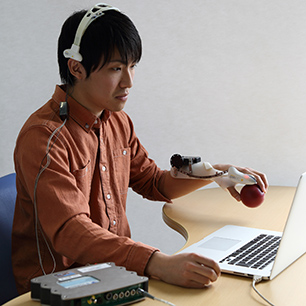Junichi Ushiba, Associate Professor, Faculty of Science and Technology, Department of Biosciences and Informatics
Connecting with the brain, connecting with people
Brain and machine directly linked, a robotic hand moves just how you imagined it would in your brain. Camera images are transmitted directly to the brain to be perceived as vision— Many similar technologies straight from the world of science fiction are now being developed under intense global competition. These types of technology are called Brain-Machine Interface (BMI) and are used to rehabilitate lost functions of the nervous system with the help of a machine. Expectations are high that these technologies will be a boon to patients with physical disabilities due to stroke or spinal cord injury. On the other hand, the development of artifacts with functional and structural affinity for living organisms—and their integration into the human body—redefine our preconceived notions about machines and make us reconsider the future role that science and engineering technology should play in the field of medicine.
My grandfather who suffered a stroke, my friend with a spinal injury, a bedridden patient met through a caregiving experience—I am moved almost daily when I witness the human vitality and dignity of those trying to overcome their challenges and the sincere warmth of their families and medical professionals involved in treatment.
Rather than artifacts which replace nature, I aim to create artifacts which complement it. With that in mind, we are now working on developing a neurotherapeutic machine which uses BMI to tune in to the brain activity of a limb which can no longer move. (Photo) The machine reads the brain activity of a stroke patient when the patient is trying to move his/her paralyzed hand while a robot assists the movement of the paralyzed hand based on information received about brain activity, inducing the brain back to its appropriate active state. Unlike conventional approaches, which replace the impaired brain function with a machine, we have tried to create a machine that helps the brain fix itself. In our joint research with the Department of Rehabilitation Medicine of the School of Medicine, we found out that even with severe hemiplegia, which has been difficult to treat using conventional approaches, muscle stiffness lessened and movement of the fingers improved using BMI technology. Today, we are moving forward with plans to commercialize the machine with a medical equipment company and are working hard day in and day out to create a neurotherapeutic machine made in Japan by Keio University.

BMI rehabilitation machine that we are now developing. What looks like a headphone affixed to the head is an electroencephalogram (EEG) sensor. Affixed to the left hand is a robot that assists the fingers to open and close. An EEG amplifier and a personal computer that analyzes brain activity in real-time are placed on the table.
*Position titles, etc., are those at the time of publishing.
